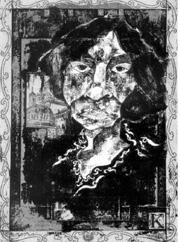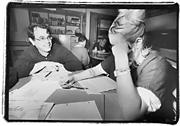I WAS IN A GIDDY MOOD as I traveled on a dark and foreboding day from Seattle to Port Townsend. It was the cusp of a full moon, the day before Friday the 13th. I was on assignment to spend the night in Washington state’s best-known real-life haunted house.
“Haaaa, haaa, haaa, eh, eh, eh, eh, eh,” I screeched to my sister long distance. “Double, double, toil and trouble. Fire burn and cauldron bubble.”
The ferry plowed the cold dark underwater of Puget Sound from Edmonds to Kingston. I read Ghost Stories of Washington to put me in the mood, cackling wildly at unsuspecting children who veered too close.
I’m not averse to ghosts. I see dead people. Dozens, every day. They aren’t the bloody-gauze-gouged-eyes sort. They are clean-cut and wear floral dresses and white T-shirts—at least in Ballard. They hang out by fire hydrants and on the front concrete steps of middle-class houses. I have learned over the years to give them a passing nod, to not stir them up.
Sometimes, I get full of myself and forget.
A classically trained journalist is not supposed to see spirits—metaphysics and reporting mix like a creative thought impinging upon an inverted pyramid. I’m not a typical journalist. I read tarot professionally (and usually secretly, although now the black cat is certainly out of the bag).
A journalism colleague recently came by accident to the back room of a Fremont bookstore where I see tarot clients. He jumped when he saw the tarot cards. “That stuff scares the shit out of me,” he said and headed toward the front of the bookstore. I followed, cackling like a witch and tapping my fingernails on his back, having a bit of fun with his shadow, until he ran out the door. Thank God, I thought as I pressed my face against the glass and watched him rush down the street, they don’t burn people like me anymore.
MANRESA CASTLE IN PORT TOWNSEND is a turn of the century manor complete with an impressive turret. Built in 1892 as a private residence, used in the mid-1920s by Jesuit priests, it became a 40-room hotel in 1968. It has European antiques, rich carpets, an ornately carved oak staircase Linda Blair would backflip over, and daily visits from the other side.
Seven years ago, the television show Sightings ran a program on the moving wall hangings, the flashing lights, the breaking glasses, and the unknown footsteps skittering nightly within the castle walls. The History Channel is running a piece this winter on Manresa for a special called Haunted Northwest.
“As people sleep, they feel a small cat or dog jump onto the bed,” says hotel manager Roger O’Connor, who explains that the hauntings have surprisingly helped, not hindered, business. “They turn on the lights and nothing is there. There are strange lights under the doors. Music is heard. Sometimes it’s a piano. Sometimes it’s a violin, sometimes a full orchestra.”
As I dropped my bags in Suite 216—a high-ceilinged room with straight-backed antiques—a quiet thought crept in: What was I doing here by myself? I felt like a lone hiker who’d come arrogantly to camp in grizzly country, my occult connection a slab of rump roast tied to my belt. I pushed the thought away and flipped through the cable channels until I found Tales from the Crypt. Sitting at the five-foot-high windows next to a gauzy curtain, I hoped passersby would think I was a ghost. My sister called at nine and pulled the string on a skeleton she’d bought for Halloween. “Come in,” the raspy voice said. “COME IN, if you dare!” We howled.
No ghosts have ever been sighted at the hotel; all anyone has recorded are moving objects, flitting shadows seen from the corner of their eyes, and the eerie sense of other presences. Several years ago a bartender, tired of hotel guests’ questions about ghosts, invented two—a Jesuit priest who hung himself from the rafters and a woman named Kate who flung herself from an upstairs window. “Kate” had heard her fianc頷as lost at sea. He wasn’t, and came home to find the dead body of his love.
People flock to Manresa Castle with Ouija boards and mediums for regular chats with Kate in room 306, from whose window she was supposed to have flung herself. (On the floor above me, in fact, four women pace in 306, waiting for the full moon, waiting for Kate.) Of course, no such suicides can be found. The bartender took Kate from the first name of the original owner’s second wife, who certainly did not commit suicide. He had to change the dates after the Sightings crew noted that Kate could not have flung herself from the window in 1921, since the castle was empty and abandoned that year. He changed the date to 1927. There is no record of a Jesuit priest killing himself.
But a lack of tragic historical figures does not mean a lack of paranormal activity. As I was soon to find out.
After two glasses of wine in the downstairs bar—where I met the father of a bride who was getting married on the castle grounds at the stroke of midnight on Friday the 13th, the night of the full moon—I went back to my suite and climbed into the short brass bed, surrounded by floral wallpaper and a view of the night lights of Port Townsend Bay.
I flung myself up in the middle of the night.
“Help me!” I screamed as if I were drowning. A woman had been sitting at the head of my bed with her left leg pressing against my pillow and pushing against the top of my hair. She had thick thighs and wore a white lacy top. It struck me as I heard my own voice echo in the dark, how many of the unexplained noises at night may well be hotel customers screaming out after a paranormal evening. I must admit I did not physically see the woman at the head of the bed, but the pressure against me felt real enough, and a picture of her surrounded me.
I lay with the blue comforter pulled to my chin for 20 minutes. Finally I risked reaching out to turn on the bedside lamp. Jumping up, I ran around and turned on every switch in the suite, four lamps and three overhead lights. I curled up on the sofa, grabbed the remote, and flipped through the channels until I came to The Brady Bunch. All night, beneath glaring lights, I watched reruns. Have you ever noticed that there is something dark and creepy about Alice?
CARL JUNG believed in ghosts. He saw them on a frequent basis. He believed the shadow side of man from which they originated was neither good nor bad, simply animal-like. Just as an animal can be tender one moment, it can be vicious the next. We humans, so separated from this animal nature, view it as brutal and inhuman.
Ghosts, like unfaithful boyfriends, can be a self-fulfilling prophecy. Canadian paranormal investigators—in what has become known as the Philip experiment—found that a group of people could come together and consciously create an entity. They then could make the entity do paranormal acts, bouncing a table across the room, for example. As Barbara Smith explains in her book Ghost Stories of Washington, the paranormal activity is real, despite the fact that it was generated from a certain “mass hysteria.”
In other words, just because ghosts can be a self-fulfilling prophecy doesn’t mean that the entity beneath the sheets isn’t real. Jung believed demons guarded the entrance to the collective unconscious. When we wrestle with these demons, we are wrestling with ourselves.
And that is exactly what it felt like, on the cusp of the full moon, at the stroke of midnight, on Friday the 13th at a castle on a hill, in a far-flung corner of the Pacific Northwest.





